Boletus L.
Recent molecular studies have shown that Boletus in its current circumscription is likely an artificial grouping and it is possible that it will be split at some point into smaller genera. Note that Boletus impolitus and Boletus depilatus for practical reasons are retained here, although there is strong evidence that they are closely related to Xerocomus subtomentosus and its allies.
Fruitbody large to medium sized, boletoid, without veil and ring. Stipe solid, with surface usually covered with granules or network. Flesh variously coloured, changing or not when exposed to air. Tubes easily separable from each other, not tearing apart. Pores usually small and rounded.
Boletus regius Krombh.
Description
Cap up to 20 cm, at first hemispherical, then convex to flat-convex, pink, dark pink to pinkish red, dry, smooth, not blueing when bruised. Stipe cylindrical to club-shaped, sometimes distinctly swollen or tapering towards the base, lemon yellow or bright yellow, in the base sometimes with red to dark red spots (especially when dried), entirely or at least in the upper half with well developed network, stipe surface not blueing when bruised. Flesh lemon yellow or bright yellow, sometimes pale pink to dirty pink at the stipe base, not blueing when exposed to air, occasionally somewhat reddening when dried. Tubes initially lemon yellow, then yellow, finally yellow with olivaceous tint, not blueing when exposed to air. Pores concolorous, not blueing when bruised. Smell not ndistinctive. Taste not distinctive. Spores 10.5–16 × 3–5 μm, ratio 2.7–4.3. Pileipellis (the cap cuticle) trichodermium of interwoven septate hyphae of cylindrical, not incrusted cells. Chemical reactions: hyphae of the flesh in the stipe base inamyloid with Melzer’s solution.
Habitat. Broadleaf forests, mycorrhizal with oaks (Quercus), beech (Fagus) or sweet chestnut (Castanea sativa).
Distribution. In Europe widespread but not found in the far north and generally more common in south.
Similarity. Boletus pseudoregius is somewhat similar, but it has dull pink to pinkish brown cap, yellow blueing flesh, blueing tubes and pores, and spores of different size. Boletus kluzakii may have similarly coloured fruitbodies but it has blueing flesh and bitter taste.
Photographs
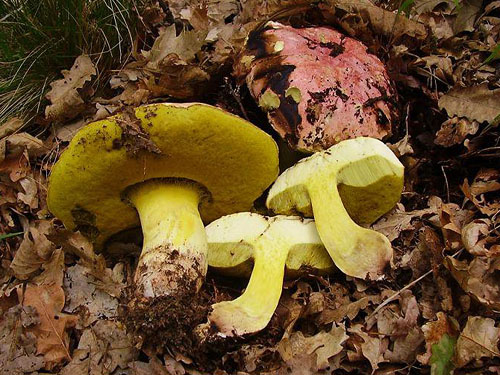
Typical collection of Boletus regius. (photo P. Nedelev)
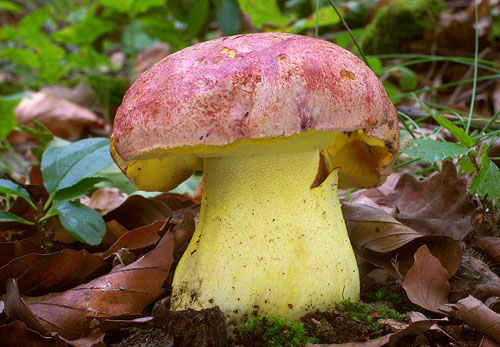
Fruitbody of Boletus regius. Note the overall colours and the network on the stipe. (photo M. Mikšík)
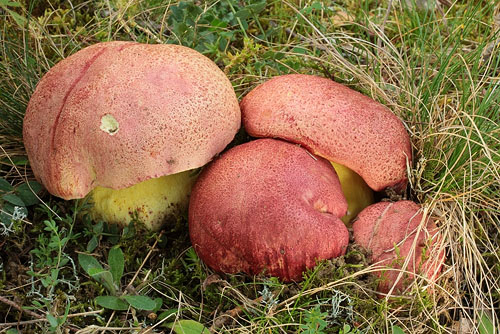
Fruitbodies of Boletus regius. (photo M. Mikšík)

Fruitbodies of Boletus regius. (photo B. Assyov)
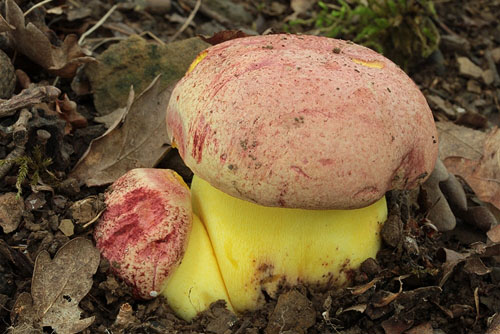
Young fruitbodies of Boletus regius. (photo M. Mikšík)

Young fruitbodies of Boletus regius. (photo B. Assyov)
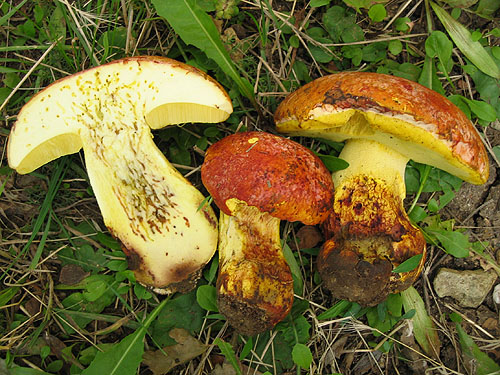
Fruitbodies of Boletus regius. Note the colours of the cap, that are slightly unusual and the unchanging flesh. (photo B. Assyov)
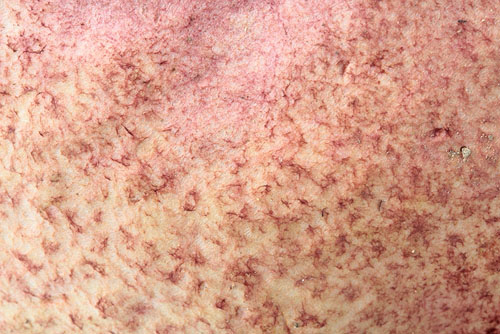
Detail of the cap surface of Boletus regius. (photo M. Mikšík)
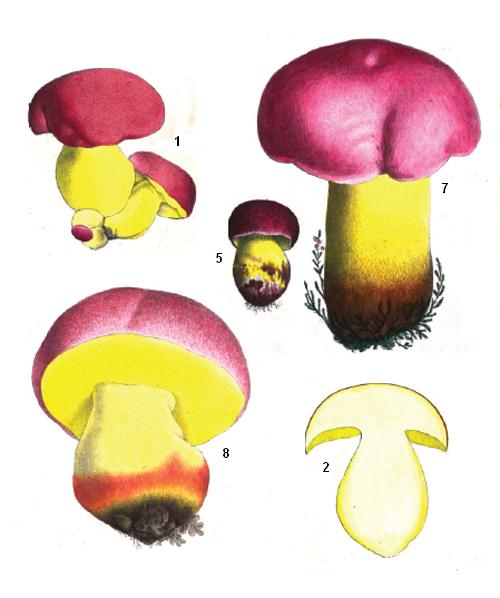
Part of Krombholz' paintings of Boletus regius acompanying the description of the species. Originally all 11 figures are set on a single plate. Numbers next to the figures are here replaced with contemporary font for reading convenience.
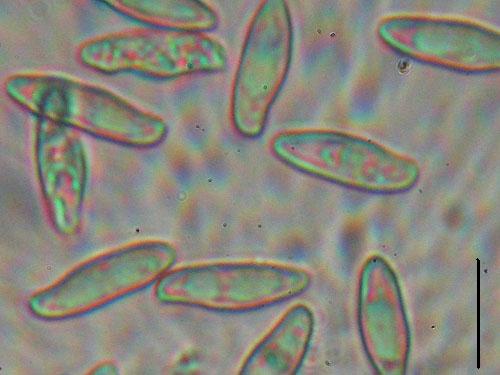
Boletus regius - spores. Scale bar = 10 μm. (photo B. Assyov)
Important literature
Alessio, C.L. 1985. Boletus Dill. ex L. (sensu lato). – In: Fungi Europaei. Vol. 2. Pp. 1–705. Libreria editrice Biella Giovanna, Saronno.
Assyov, B. (2012). Revision of Boletus section Appendiculati (Boletaceae) in Bulgaria with a key to the Balkan species. – Turkish Journal of Botany 36: 408–419. (available online)
Engel, H., Krieglsteiner, G., Dermek, A. & Watling, R. 1983. Dickröhrlinge. Die Gattung Boletus in Europa. Verlag Heinz Engel, Weidhausen b. Coburg.
Estadès, A. & Lannoy, G. 2004. Les bolets européens. – Bulletin Mycologique et Botanique Dauphiné-Savoie 44(3): 3–79.
Galli, R. 1998. I Boleti. Atlante pratico-monographico per la determinazione dei boleti. Edinatura, Milano.
Lannoy, G. & Estadès, A. 2001. Les Bolets. Flore mycologique d’Europe. Documents Mycologiques Mémoire Hors série no. 6. Pp. 1–163. Association d’Écologie et de Mycologie, Lille.
Marques, G. & Muñoz, J.A. 2006. Révision des espèces européennes du genre Boletus section Appendiculati. Étude sur la base de caracteres morphologique et d’analyse des polymorphismes des fragments de restriction (PCR-RFLP). – Bulletin Trimestriel de la Société Mycologique de France 122: 353–366.
Muñoz, J.A. 2005. Boletus s. l. – In: Fungi Europaei. Vol. 1. Pp. 1–951. Edizioni Candusso, Alassio.
Pilát, A. & Dermek, A. 1974. Hríbovité huby. Československé hríbovité a sliziakovité huby (Boletaceae – Gomphidiaceae). Veda, Bratislava.
Singer, R. 1967. Die Röhrlinge. II. Die Boletoideae und Strobilomycetaceae. – In: Die Pilze Mitteleuropas. Vol. 6. Pp. 1–151. Julius Klinkhardt Verlag, Bad Heilbrunn.
Šutara, J., Mikšík, M. & Janda, V. 2009. Hřibovité houby. Čeled’ Boletaceae a rody Gyrodon, Gyroporus, Boletinus a Suillus. Academia, Praha.
Watling, R. 1970. Boletaceae, Gomphidiaceae, Paxillaceae. – In: Henderson, D.M., Orton, P.D. & Watling, R. [eds]. British fungus flora. Agarics and Boleti. Vol. 1. Royal Botanic Garden, Edinburgh.
Watling, R. & Hills, A.E. 2005. Boletes and their allies (revised and enlarged edition). – In: Henderson, D.M., Orton, P.D. & Watling, R. [eds]. British Fungus Flora. Agarics and boleti. Vol. 1. Royal Botanic Garden, Edinburgh.